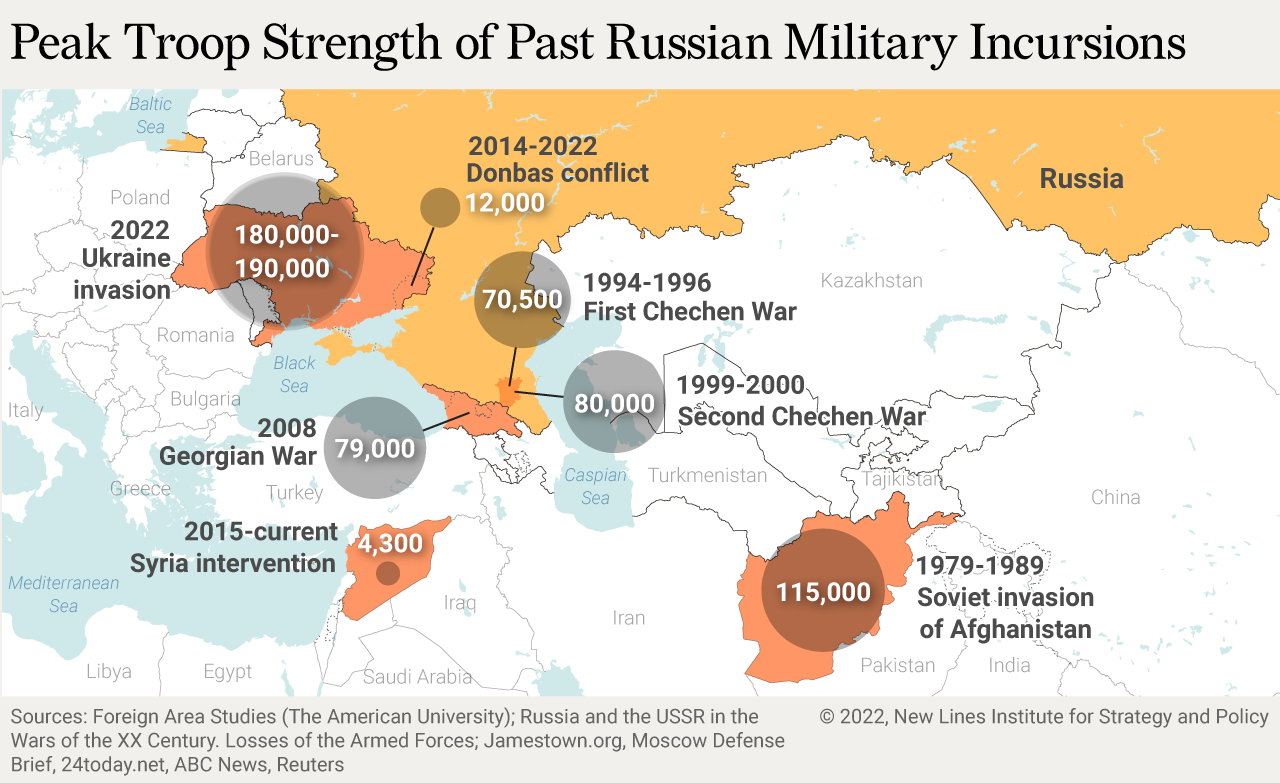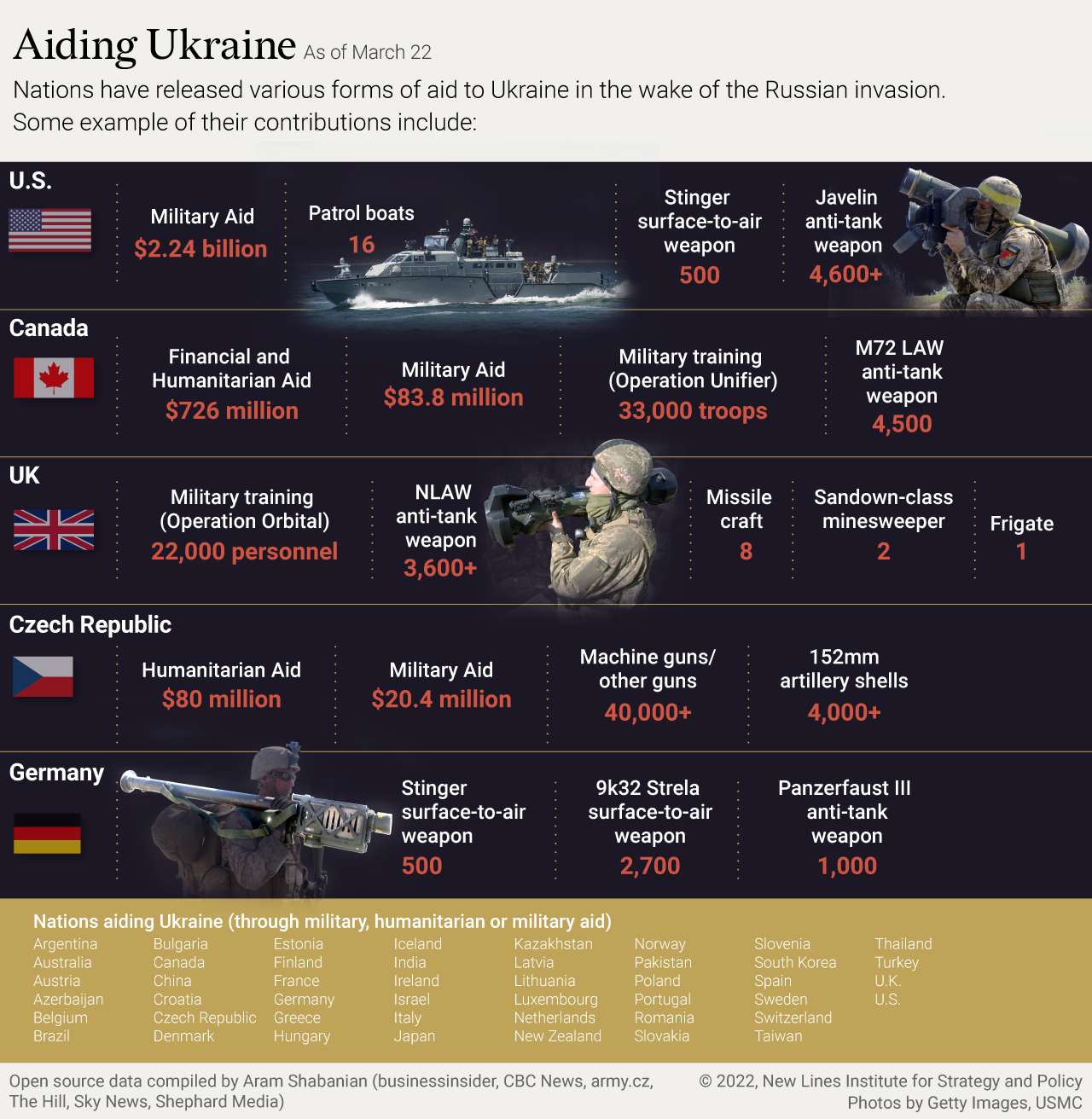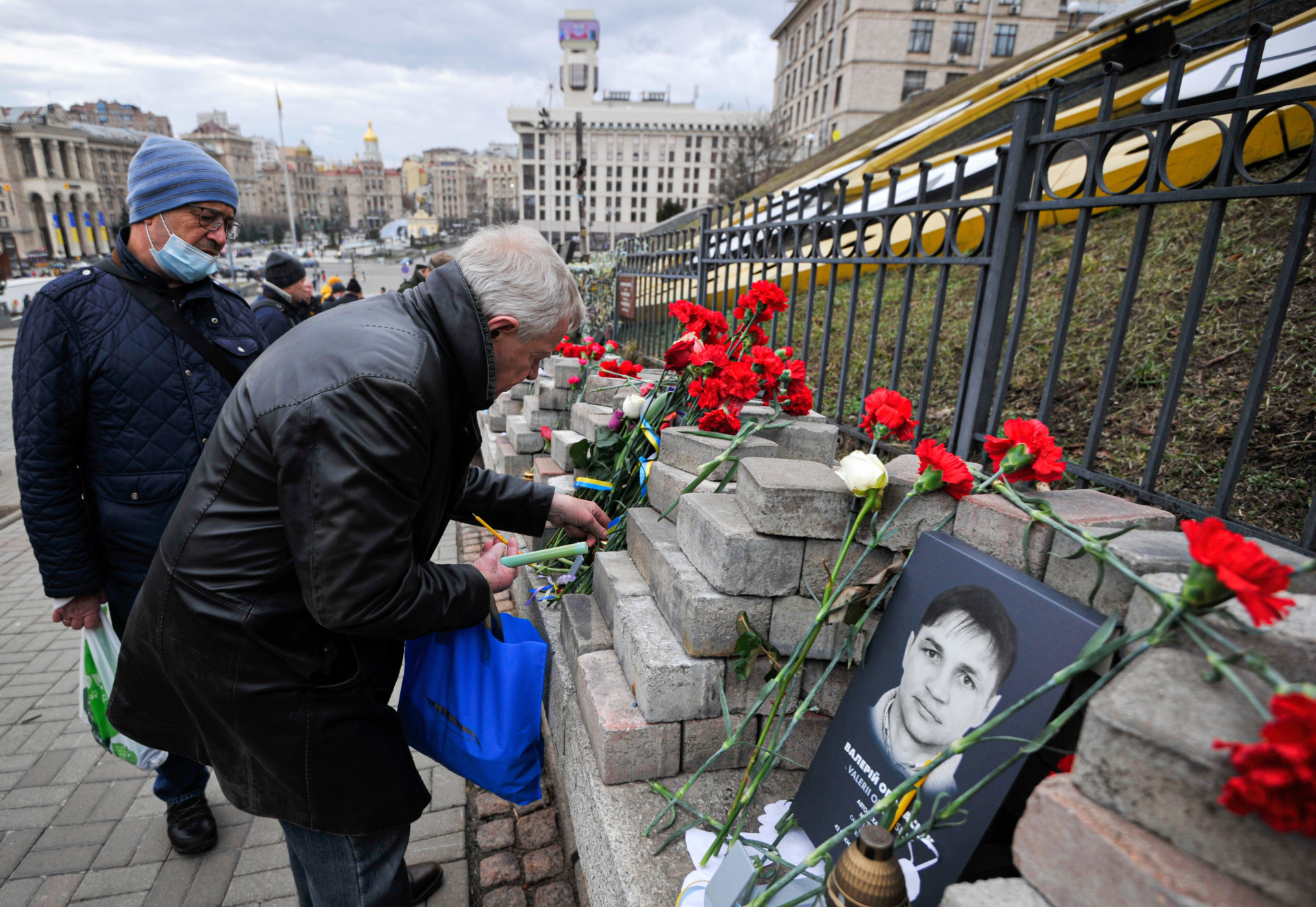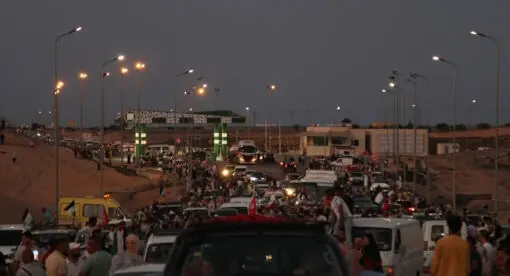Russian President Vladimir Putin’s invasion of Ukraine stems from his chronic concern that popular revolutions will further limit Russia’s ability to control its neighbors and will eventually threaten the Kremlin’s grip on power. Putin’s concern over popular revolutions has steadily grown in parallel with the number of large-scale, nonviolent movements that deposed the old guard in the former Yugoslavia and the broader former Soviet space over the past 20 years – a concern that boiled over with Ukraine’s 2014 Revolution of Dignity.
While Kremlin-controlled security forces continue to go to great lengths to repress popular activism at home, the invasion of Ukraine is ironically driving up coordinated anti-Putin activism both abroad and domestically. While international pressure is mounting in response to Moscow’s aggression against Ukraine, in Russia people are protesting for greater political freedoms and to hold the Kremlin accountable for the catastrophic economic fallout from the war.
The United States and its allies can help advance the cause of democracy by meaningfully bolstering nonviolent efforts against oppressive regimes in the former Soviet space. This would involve endorsing these movements as the legitimate voice of the people and proactively sanctioning individuals, government entities, and companies stifling activists’ freedom of expression. Backing such movements early on may help prevent large-scale crackdowns on dissidence such as those led by the Kremlin against Russia’s nonviolent opposition in the wake of previous military engagements.

Tracing Russian Paranoia Over Popular Revolutions
The Kremlin’s fear of a fresh popular revolution threatening its position in power isn’t far-fetched; history favors nonviolent movements, which boast a 53% success rate compared with the 26% success rate for violent campaigns. In Russia’s neighborhood, civil resistance has proved itself to be a particularly potent strategy – between 1900 and 2019, 58% of the region’s major nonviolent movements succeeded in achieving their goals.
While Russia’s “special military operation” launched on Feb. 24 to “denazify” Ukraine came as a shock to many, Putin’s fear of popular revolutions means he has been plotting to regain control in Ukraine ever since a popular revolution in February 2014 deposed Kremlin-backed president Viktor Yanukovych. What is becoming clearer as the war drags on is that Putin believed his efforts to quash Ukraine’s budding democracy would result in Russia’s uncontested success, as they did in preventing social movements seeking political change in Georgia and Syria.
Russia’s Far-reaching Efforts in Georgia
Prior to its 2003 Rose Revolution, Georgia, which was once one of the most prosperous Soviet republics, had economically stagnated. The economic and political situation was further worsened by protracted territorial tensions with the breakaway regions of Abkhazia and South Ossetia and the Autonomous Republic of Adjara.
After the revolution, Georgia, under the leadership of democratically elected, pro-Western President Mikheil Saakashvili, began pursuing a broad set of reforms and reoriented its foreign policy away from Russia. Saakashvili’s government also successfully reasserted its control over the Republic of Adjara using coercive diplomacy. While Moscow’s stake in the political fate of this geographically removed region had been minor, Tbilisi’s success threatened Russia’s final footholds in Georgia, a country the Kremlin used as a controlled buffer between NATO member Turkey and Russia proper, and as a critical smuggling corridor to move arms, narcotics, and nuclear materials via the Black Sea.
Tensions between South Ossetian separatists and Georgian military forces steadily escalated following the reintegration of Adjara. Russia aggravated the situation further by providing arms and Russian passports to the autonomous republic. In July 2008, tensions reached a new peak as Russia amassed 8,000 troops at the South Ossetian border under the pretext of conducting a military exercise, and on Aug. 8, Russia launched a large-scale land, air and sea military invasion after Georgian troops advanced on the breakaway region’s capital city, Tskhinvali. Similar to the 2022 assertion of “genocide” targeting ethnic Russians in eastern Ukraine, Russia was quick to accuse Georgia of ethnic cleansing in South Ossetia to justify its military action.
In the decade after the war, it became clear that Russia was actively working to install a pro-Kremlin government in Tbilisi and halt Georgia’s democratization in order to preserve its geostrategic footing in the Black Sea and to halt NATO, as well as Western economic and diplomatic expansion, into the Southern Caucasus and Central Asia. When mass anti-Russia street protests erupted in 2019, the Kremlinhad Tbilisi, which was dominated by the pro-Moscow Georgian Dream party, jail a major opposition member of parliament and tamper with electoral reform negotiations, thereby ensuring the party’s victory in 2020 parliamentary elections. The Georgian Dream Party has been working overtime ever since to consolidate power and to subvert accountability from whatever the Kremlin decides to do next.
The Kremlin’s Battle Against Popular Revolutions Expands to Syria
The 2011 Arab Spring uprisings have further contributed to Putin’s paranoia over the ripple effect of popular revolutions. Russia’s regional ally Syria was under pressure, with swelling protests demanding the end of the Assad family’s 40-year reign. Despite the Syrian regime’s reputation for violent repression, the popular demonstrations were a source of grave concern for Putin; only weeks prior, popular revolutions had caused the ouster of the presidents of Tunisia and Egypt. The nonviolent toppling of another tenured Arab dictator was unacceptable.
The Soviet Union, and later Russia, heavily invested in Assad regime. In 1971, then-President Hafez al-Assad paved the way for establishing a Soviet naval military base in Tartus, giving Moscow a geostrategic presence in the Middle East and eastern Mediterranean Sea. Later in 2005, Russia forgave Syria 73% of its $13.4 billion Soviet-era debt and became Syria’s top arms supplier.
Protests against President Bashar Al-Assad’s regime first sprung up in the southern city of Daraa on March 15, 2011, after the mukhabarat jailed and tortured 15 young students from prominent local families on charges of spreading anti-government graffiti across the city. The Kremlin quickly stepped up its support for the Assads, securing $1 billion in arms sales to the Syrian military in a bid to help the government impose its own crackdown on protests.
In a few weeks after the crackdown began, the death toll among protesters had steeply risen and fighting had broken out. Despite the Syrian opposition and Western governments’ efforts to persuade Russia to halt arms transfers to the Syrian regime, the Kremlin continued supporting Assad.
Three years into the civil war, the U.N. stopped its casualty count, stating that the violence was too far-reaching for any organization or government to accurately track. The Syrian government had lost control of over 80% of the country. It seemed that Assad might lose to rebels, extremists, or both. To secure his regime against collapse, Assad requested Russian “military aid” to combat the rebel groups in mid-2014. After less than a month of conducting air strikes on behalf of the government, Putin announced in a televised interview that Russia would be leading an “operation” in Syria with the goal of “stabilizing the legitimate power […] and creating the conditions for political compromise.”
The 2015 Russian invasion of Syria proved fruitful for the Assad regime, whose forces as of late February 2022 maintain control of over two-thirds of the country. Much of this extraordinary gain for the government is owed to the Russian military intervention as well as to Russia’s military strategy, wherein deliberately targeting civilians and aid workers in air strikes is the name of the game.
Russia’s interventions in Syria and Georgia have served to boost Putin’s confidence that brute violence is the most effective method of stifling popular nonviolent dissidence. With Assad secure in Damascus and Tbilisi under his thumb, Putin reconcentrated his attention on Ukraine.
Russian Panic Over Ukraine’s Democratization
Nine years after Ukraine’s Orange Revolution, a fresh wave of large-scale protests erupted in November 2013, with the heart of the movement centered in Kyiv’s Maidan Nezalezhnosti (Independence Square). Demonstrations grew after then-President Yanukovych refused to sign an associative and trade agreement with the European Union. Days prior to his decision, Putin seduced Yanukovych with a $15 billion economic aid package to help Kyiv climb out of a deep fiscal crisis and to persuade Ukraine to pause its progression in fulfilling the democratization requirements needed for European Union membership. Achieving the ascension into the EU would not only reduce Ukrainian economic dependency on Russia but would also mean that the country had made significant progress towards democratization.
In the wake of sustained protests, Yanukovych fled the country on Feb. 21, 2014. The events, which left as many as 1,100 protesters and police dead, became known as the “Revolution of Dignity.” The Kremlin, however, denounced the revolution branding it as an “anti-constitutional coup and military seizure of power.”
Russia quickly began implementing a trilateral strategy to destabilize Ukraine involving a ferocious disinformation campaign that has branded the democratically elected government as a neo-fascist junta pursuing a reign of antisemitism; the annexation of Crimea; and a proxy war through pro-Russia separatist groups in Ukraine’s eastern Donetsk and Luhansk oblasts.
In Russia, 2014 is most often remembered as the year that gave rise to “the Crimea effect,” the phenomenon that brought Putin’s approval ratings to unprecedented heights. However, against the backdrop of collective euphoria, Russia witnessed some of the largest protests in its modern history as some 20,000 people marched on the streets of Moscow to demand Russia’s withdrawal from the conflict in eastern Ukraine.
In November of that same year, Putin was quoted saying, “For us, [Ukraine’s 2014 revolution] is a lesson and a warning,” adding, “We will do everything to ensure that [a similar uprising] will never happen in Russia.” Just a few months after the comment, the charismatic leader of Russia’s anti-war protest movement, Boris Nemtsov, was brutally murdered in Moscow.
Five years since the annexation of Crimea and the start of the war in the Donbas region, Russia continued to push its proxy war and disinformation campaign branding the Ukrainian government as fascists, but Putin’s goals were dealt a blow when political novice Volodymyr Zelenskyy won the Ukrainian presidency in the spring of 2019.
At home, Putin’s government continued to safeguard the Kremlin by tactically disintegrating opposition networks. The seriousness of Putin’s intention became evident in 2019 after protests erupted over alleged violations of the electoral law during Moscow City Duma elections. The rallies were brutally suppressed; thousands of participants were arrested, and nearly all prominent protest leaders were jailed.
In Russia’s federal subjects, with the exception of Ramzan Kadyrov’s Chechnya, nonviolent protests over local issues also became more frequent. Beyond the well-known tactics of preemptive arrests of protest leaders and mass arrests at the protest scenes, the Kremlin pioneered the use of extremism charges against protest leaders and related civil society organizations in Muslim-majority regions such as the republics of Bashkortostan and Ingushetia.
Proving a successful tool to crack down on regional dissidence, the “extremist” label was used on a far larger scale in the spring of 2021 as the Kremlin moved to dismantle the Anti-Corruption Foundation (FBK) founded by prominent opposition leader Alexei Navalny. With a network of 50 regional headquarters, the organization has proven to be the most effective opposition force capable of mobilizing a countrywide nonviolent resistance campaign. In January 2021, the FBK successfully mobilized thousands of protesters across the country to come out in support of a jailed Navalny and, despite the rally recording the highest number of arrests in a single day of more than 5,500 people, the FBK managed to maintain its momentum for several weeks.
With Navalny in jail, his allies in forced exile, and a countrywide network of activists crumpled, the Kremlin made a final push to prepare for the invasion of Ukraine.
The Invasion Launches and Swiftly Backfires
Vladimir Putin’s ominous Feb. 21 speech dedicated to the recognition of separatist Donetsk and Luhansk people’s republics provided further hints to the Kremlin’s overarching fear of popular revolutions.
Beyond attributing the establishment of Ukrainian statehood to the mere chance offered by “strategic mistakes of the Bolshevik leaders,” Putin further articulated his longstanding belief that all popular revolutions are, in fact, mere products of Western interventionism and political manipulation.
“The external forces have played a role in this as well, using a widespread network of NGOs and intelligence agencies [they] cultivated their followers in Ukraine and integrated them into the government,” Putin explained.

By suggesting that popular movements have been instigated by Ukraine’s “extreme nationalist,” “neo-Nazi” forces nurtured by the West, while also asserting that the same forces are responsible for destabilizing Russia’s Republic of Chechnya, Putin has paved the ideological ground for employing “extremism” charges against activists at home. To him, activists and extremist Islamist groups are equally dangerous forces threatening the core of the Kremlin’s Russkiy mir (“Russian world”) ideology.
“It is not surprising that Ukrainian society has witnessed the growth of extreme nationalism that quickly transformed into aggressive Russophobia and neo-Nazism,” Putin said. “From that stems the participation of Ukrainian nationalists and neo-Nazis in terrorist groups in the North Caucasus and ever stronger claims for Russia’s territory.”
The activists’ attack on Russia’s statehood, according to Putin’s worldview, culminated during Ukraine’s 2014 Revolution of Dignity. That’s when “radicals […] financed by the foreign states” managed to exploit grievances of ordinary people and stage a “coup d’état.”
To Putin, therefore, the ongoing invasion is a mission of liberation, not only of the Ukrainian people whom he sees as sheep-like victims of nonviolent activism but also of Russians whom he fears could fall prey to ideas of freedom “imported” from the West. However, both the fierce Ukrainian resistance and growing coordinated global reaction shows just how much the long-reigning Russian leader has been mistaken.
While NATO leaders drew up sanctions, hundreds of global protests popped up demanding an end to the Russian invasion. These coordinated grassroots efforts, led by student groups, Ukrainian communities abroad, military veterans, and established activist networks have augmented anti-Russian moves by governments and global corporations.
In some cases, corporations have directly thwarted Putin’s efforts. For example, hours before Russian tanks penetrated Ukraine, Microsoft detected Russian “wiper” malware and distributed a blocker code through the U.S. government to mitigate any attempt to erase Ukrainian network data. These efforts are collectively hitting the Russian economy hard. On March 3, Moody’s downgraded Russia’s credit rating to junk while the value of the ruble continues to tumble.

With opposition networks destroyed and Navalny being put on a second trial, the Kremlin likely expected to face little defiance to its actions at home. Nevertheless, anti-war protests broke out on the day of the invasion, with several thousand people gathering in central Moscow and St. Petersburg. Hundreds of others gathered across 56 other cities. More than 1,800 people were arrested on the first day, though it did little to stop the momentum. Large rallies and single-person pickets continue nationwide. According to Russia’s independent human rights monitor OVD-info, at least 8,170 anti-war protesters were arrested in the first week of the war, including children and the elderly.
With mass arrests threatening to stifle Russia’s anti-war movement, its leaders have adopted other tools of nonviolent resistance. Opposition politicians and influential independent academics have called on those unable to join the protests to leverage legal mechanisms to pressure Russia’s State Duma deputies to take a stance against the war. With Russia’s civil society remaining largely underdeveloped, utilizing constitutionally guaranteed mechanisms to pressure the government has the potential to catalyze schisms within the regime.

Fueling Meaningful Change
While people across the former Soviet space and beyond believe that Russia maintains the upper hand militarily in Ukraine, Putin’s attempt to dissuade any forms of dissidence by invading Ukraine is actively backfiring. Many will join Ukrainians on the front lines; however, others will attempt to undermine Putin using the more effective alternatives: boycott, nonviolent protest, civil disobedience, and noncooperation. Despite the unprecedented crackdown, we expect Russia’s anti-war resistance movement to maintain momentum both within the country and outside, partly due to persistent efforts of exiled members of the opposition and activists. An independent poll published on March 3 by Navalny’s FBK confirmed that the activists’ efforts are not in vain: Anti-war sentiment amongst Russians has been growing rapidly since the war began.
The drive for sustainable change will only increase with each new violent measure that Russia takes. As international policymakers find themselves unable to assert direct military action against the Kremlin without risking nuclear war, it is crucial to support nonviolent efforts to dispel Putin’s power. To do so, policy makers must:
- Meaningfully engage nonviolent protest leaders across the world and endorse their efforts as the legitimate voice of the people
- Directly sanction those who repress activists’ freedom to assemble and freedom of speech
- Use the vast resources held by international corporations and high-net-worth individuals to proactively debunk the Kremlin’s disinformation campaigns and to thwart malicious cyber attacks
- Proactively endorse Russia’s activism community in exile amid an ongoing violent crackdown at home
Isabella Cuomo is the Director of Research and Development at Build A Movement. As a dedicated practitioner in the field of nonviolent struggle and subject matter expert in international security, her activities currently focus on how activist movements can successfully steer civil resistance transitions post-revolution to achieve sustainable democratization.
Leyla Latypova is a geopolitical risk analyst and journalist. Latypova is currently pursuing a postgraduate degree at UCL School of Slavonic and East European Studies, where her primary research focus is on social movements and regional mobilization in Russia.
The views expressed in this article are those of the author and not an official policy or position of the New Lines Institute.






